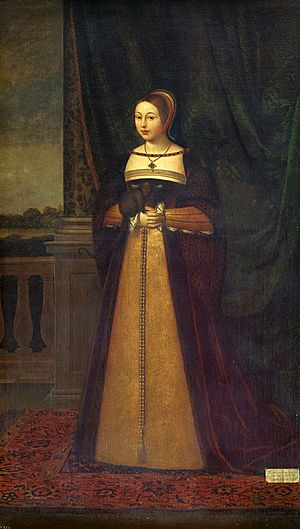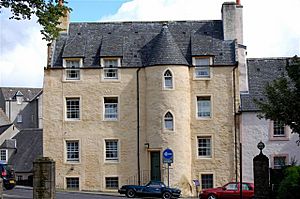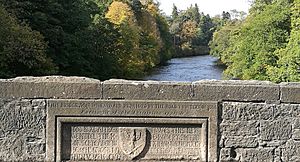Robert Spittell facts for kids
Robert Spittell (also spelled Spittall or Spittale) was a skilled Scottish tailor who lived in the 1500s. He worked for Margaret Tudor, who was the queen of James IV of Scotland. Robert Spittell was known for making clothes for the royal family and other important people at court. He also used his money to help build important things like bridges and a hospital.


Making Clothes for the Queen
When Queen Margaret Tudor first arrived in Scotland, she had her own tailor from England. In 1504, this English tailor changed some of her dresses and fixed others.
Later, in 1507, another tailor named William Welsch made a very special dress for Queen Margaret. This dress was made from expensive fabrics like velvet and shiny cloth of gold. These materials were brought in by an Italian merchant named Jerome Frescobaldi. Historians believe this fancy dress was likely for a special ceremony after the Queen had her first baby. This ceremony marked her return to public life at court.
Robert Spittell's Royal Work
Robert Spittell became the Queen's tailor. In 1509, his yearly pay was £10 Scots. In 1511, he was listed as one of the Queen's male servants. Around Christmas that year, he received a special uniform, called a "livery gown." It was made of brown "Rissillis" cloth, which came from a place now called Lille in France. His jacket also had black velvet edges. Other servants, including Ellen More, an African servant, also received clothes made from these fabrics. In 1513, he was given land near Doune Castle.
Spittell made clothes for Eleanor Musgrave, an English lady at court. She is mentioned in a poem by William Dunbar called Of a Dance in the Quenis Chamber. In 1511, he made her dresses, head coverings, and a French hood. He also fixed her clothes and provided ribbons and cuffs.
Robert Spittell was good at reusing clothes. In 1511, he took an old white satin dress and turned it into a "kirtle" (a type of gown or skirt). He gave it a new lining of "Scottish black" fabric for Queen Margaret. In 1512, he added velvet lining to a pair of sleeves for one of the Queen's gold dresses.
He also made clothes for Prince James in 1512 and 1513. After the Battle of Flodden in 1513, when Prince James became king as a baby, a different tailor named Andrew Edgar made his clothes.
In May 1514, Queen Margaret Tudor was in charge of Scotland as Regent. She gave Robert Spittell an income from lands near Gargunnock.
After Queen Margaret left Scotland in 1516, Spittell helped deliver some of her belongings. These included fur trimmings for dresses and sleeves. Records show he also sewed fur onto her stomachers (a decorated piece worn over the chest).
Spittell's Life in Stirling
Records from the town of Stirling show that Robert Spittell was still known as the Queen's servant in 1521. He bought several houses in Stirling. In 1527, during a disagreement about land, he said that a dying neighbor had called him a good neighbor.
Robert Spittell used his own money to pay for bridges to be built. He funded a bridge over the Bannockburn stream and another over the Teith near Doune. In 1530, he also started a special home for people in need in Stirling, which was called Spittel's Hospital.
He passed away in 1558.
The bridge he built over the River Teith had an inscription. It said, "In God is all my trust." It also stated that the bridge was built on September 10, 1535, by Robert Spittell, tailor to Queen Margaret. The inscription also included his coat of arms, which featured an eagle and tailor's scissors.
It is also believed that he paid for a bridge at Tullibody over the River Devon. During a time of big changes in Scotland called the Scottish Reformation, in 1560, a man named William Kirkcaldy of Grange broke part of the Tullibody bridge. He did this to slow down French soldiers who were heading to Stirling Castle. The French commander, Henri Cleutin, even took the roof off the nearby Tullibody Auld Kirk (old church) to fix the bridge.


